Cultural Tourism Intepretation | report
VerifiedAdded on 2022/10/02
|9
|2084
|10
Assignment
AI Summary
Contribute Materials
Your contribution can guide someone’s learning journey. Share your
documents today.
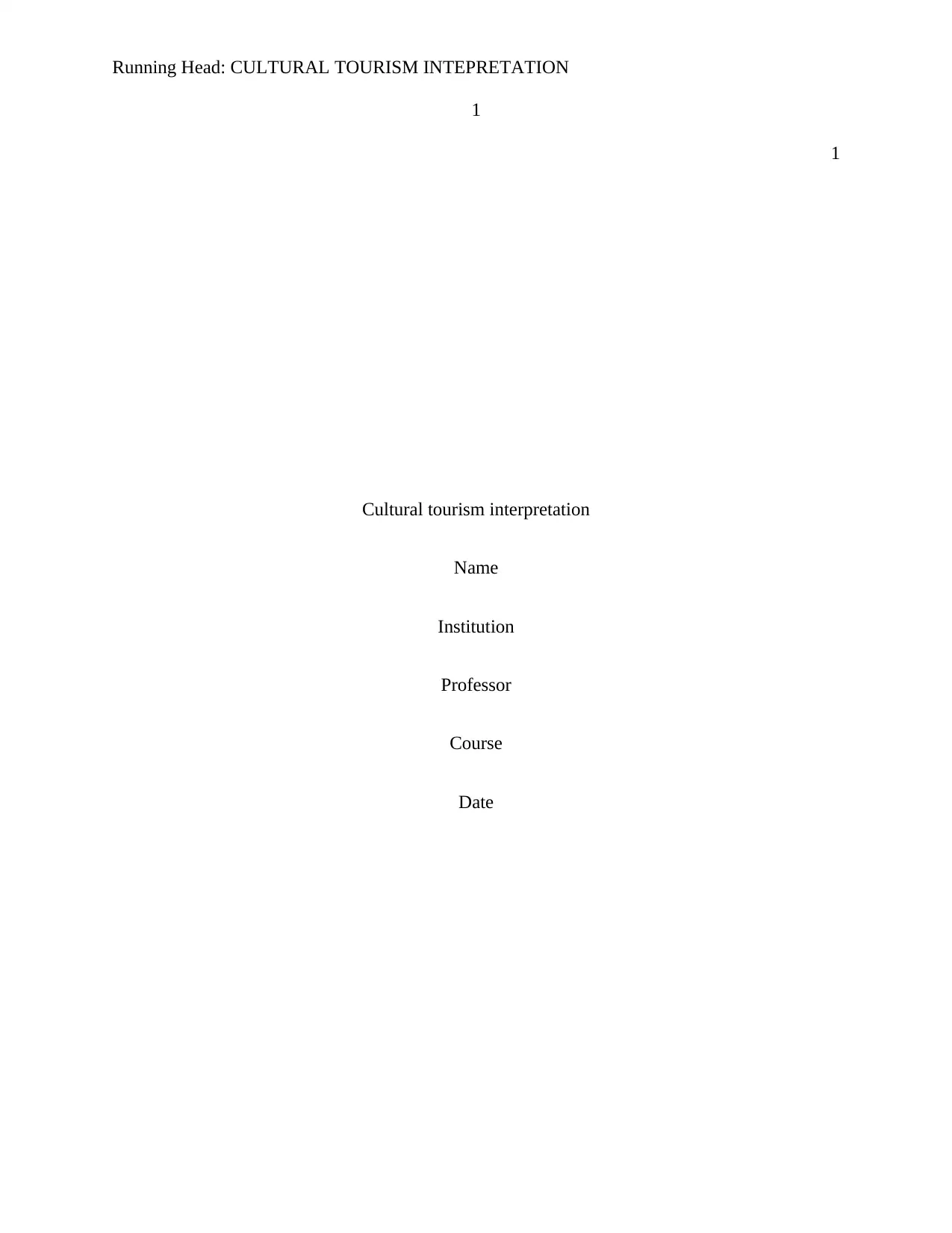
Running Head: CULTURAL TOURISM INTEPRETATION
1
1
Cultural tourism interpretation
Name
Institution
Professor
Course
Date
1
1
Cultural tourism interpretation
Name
Institution
Professor
Course
Date
Secure Best Marks with AI Grader
Need help grading? Try our AI Grader for instant feedback on your assignments.
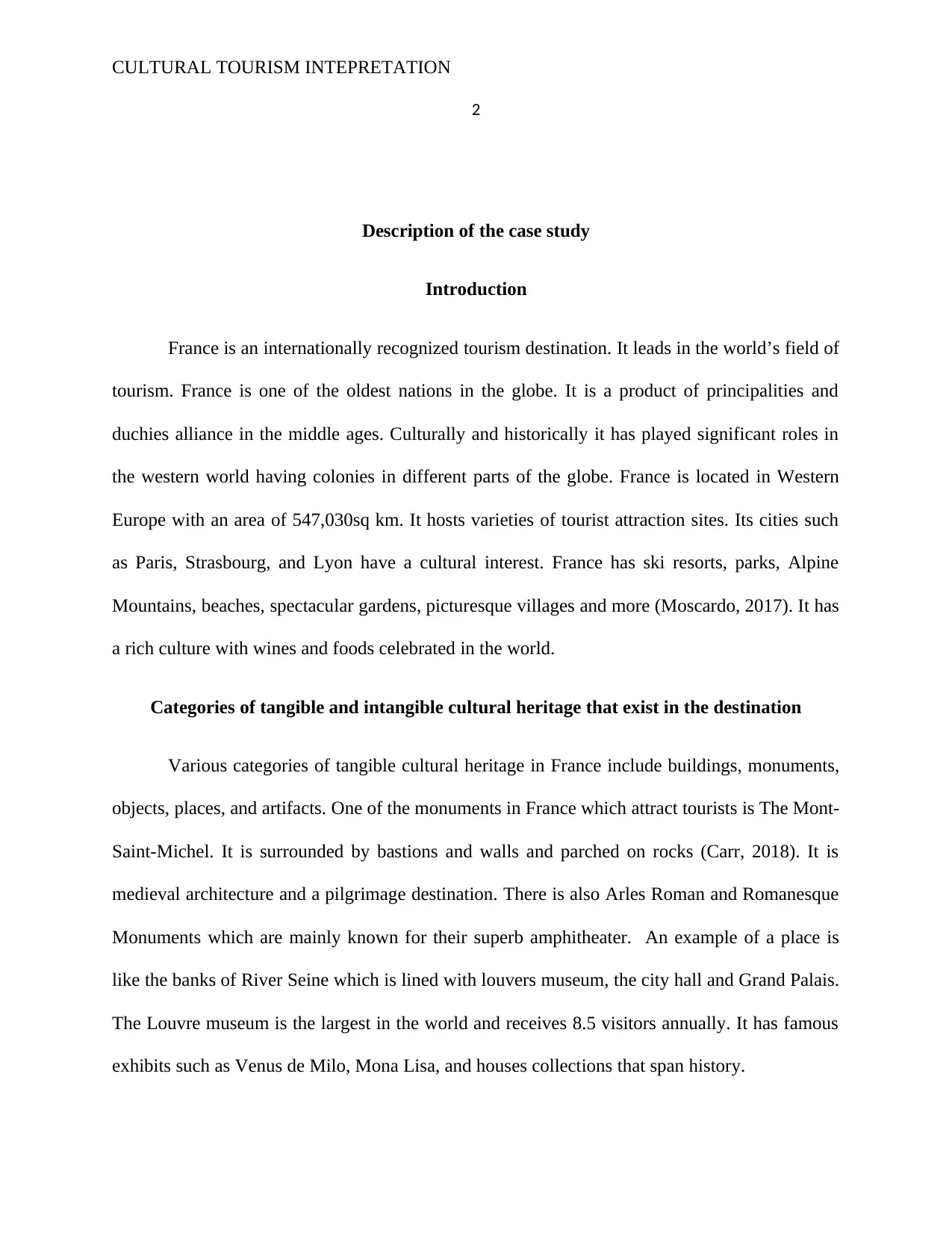
CULTURAL TOURISM INTEPRETATION
2
Description of the case study
Introduction
France is an internationally recognized tourism destination. It leads in the world’s field of
tourism. France is one of the oldest nations in the globe. It is a product of principalities and
duchies alliance in the middle ages. Culturally and historically it has played significant roles in
the western world having colonies in different parts of the globe. France is located in Western
Europe with an area of 547,030sq km. It hosts varieties of tourist attraction sites. Its cities such
as Paris, Strasbourg, and Lyon have a cultural interest. France has ski resorts, parks, Alpine
Mountains, beaches, spectacular gardens, picturesque villages and more (Moscardo, 2017). It has
a rich culture with wines and foods celebrated in the world.
Categories of tangible and intangible cultural heritage that exist in the destination
Various categories of tangible cultural heritage in France include buildings, monuments,
objects, places, and artifacts. One of the monuments in France which attract tourists is The Mont-
Saint-Michel. It is surrounded by bastions and walls and parched on rocks (Carr, 2018). It is
medieval architecture and a pilgrimage destination. There is also Arles Roman and Romanesque
Monuments which are mainly known for their superb amphitheater. An example of a place is
like the banks of River Seine which is lined with louvers museum, the city hall and Grand Palais.
The Louvre museum is the largest in the world and receives 8.5 visitors annually. It has famous
exhibits such as Venus de Milo, Mona Lisa, and houses collections that span history.
2
Description of the case study
Introduction
France is an internationally recognized tourism destination. It leads in the world’s field of
tourism. France is one of the oldest nations in the globe. It is a product of principalities and
duchies alliance in the middle ages. Culturally and historically it has played significant roles in
the western world having colonies in different parts of the globe. France is located in Western
Europe with an area of 547,030sq km. It hosts varieties of tourist attraction sites. Its cities such
as Paris, Strasbourg, and Lyon have a cultural interest. France has ski resorts, parks, Alpine
Mountains, beaches, spectacular gardens, picturesque villages and more (Moscardo, 2017). It has
a rich culture with wines and foods celebrated in the world.
Categories of tangible and intangible cultural heritage that exist in the destination
Various categories of tangible cultural heritage in France include buildings, monuments,
objects, places, and artifacts. One of the monuments in France which attract tourists is The Mont-
Saint-Michel. It is surrounded by bastions and walls and parched on rocks (Carr, 2018). It is
medieval architecture and a pilgrimage destination. There is also Arles Roman and Romanesque
Monuments which are mainly known for their superb amphitheater. An example of a place is
like the banks of River Seine which is lined with louvers museum, the city hall and Grand Palais.
The Louvre museum is the largest in the world and receives 8.5 visitors annually. It has famous
exhibits such as Venus de Milo, Mona Lisa, and houses collections that span history.
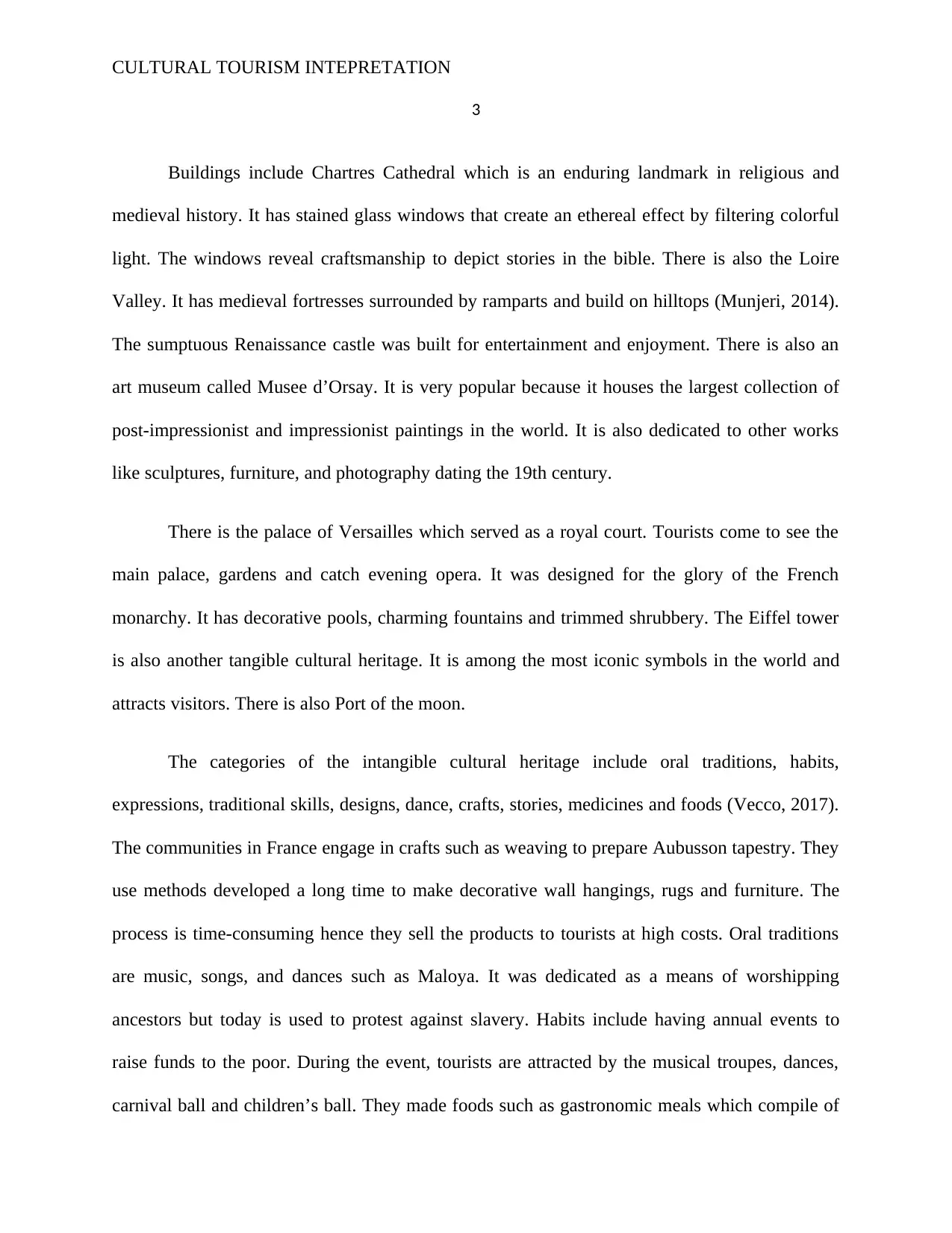
CULTURAL TOURISM INTEPRETATION
3
Buildings include Chartres Cathedral which is an enduring landmark in religious and
medieval history. It has stained glass windows that create an ethereal effect by filtering colorful
light. The windows reveal craftsmanship to depict stories in the bible. There is also the Loire
Valley. It has medieval fortresses surrounded by ramparts and build on hilltops (Munjeri, 2014).
The sumptuous Renaissance castle was built for entertainment and enjoyment. There is also an
art museum called Musee d’Orsay. It is very popular because it houses the largest collection of
post-impressionist and impressionist paintings in the world. It is also dedicated to other works
like sculptures, furniture, and photography dating the 19th century.
There is the palace of Versailles which served as a royal court. Tourists come to see the
main palace, gardens and catch evening opera. It was designed for the glory of the French
monarchy. It has decorative pools, charming fountains and trimmed shrubbery. The Eiffel tower
is also another tangible cultural heritage. It is among the most iconic symbols in the world and
attracts visitors. There is also Port of the moon.
The categories of the intangible cultural heritage include oral traditions, habits,
expressions, traditional skills, designs, dance, crafts, stories, medicines and foods (Vecco, 2017).
The communities in France engage in crafts such as weaving to prepare Aubusson tapestry. They
use methods developed a long time to make decorative wall hangings, rugs and furniture. The
process is time-consuming hence they sell the products to tourists at high costs. Oral traditions
are music, songs, and dances such as Maloya. It was dedicated as a means of worshipping
ancestors but today is used to protest against slavery. Habits include having annual events to
raise funds to the poor. During the event, tourists are attracted by the musical troupes, dances,
carnival ball and children’s ball. They made foods such as gastronomic meals which compile of
3
Buildings include Chartres Cathedral which is an enduring landmark in religious and
medieval history. It has stained glass windows that create an ethereal effect by filtering colorful
light. The windows reveal craftsmanship to depict stories in the bible. There is also the Loire
Valley. It has medieval fortresses surrounded by ramparts and build on hilltops (Munjeri, 2014).
The sumptuous Renaissance castle was built for entertainment and enjoyment. There is also an
art museum called Musee d’Orsay. It is very popular because it houses the largest collection of
post-impressionist and impressionist paintings in the world. It is also dedicated to other works
like sculptures, furniture, and photography dating the 19th century.
There is the palace of Versailles which served as a royal court. Tourists come to see the
main palace, gardens and catch evening opera. It was designed for the glory of the French
monarchy. It has decorative pools, charming fountains and trimmed shrubbery. The Eiffel tower
is also another tangible cultural heritage. It is among the most iconic symbols in the world and
attracts visitors. There is also Port of the moon.
The categories of the intangible cultural heritage include oral traditions, habits,
expressions, traditional skills, designs, dance, crafts, stories, medicines and foods (Vecco, 2017).
The communities in France engage in crafts such as weaving to prepare Aubusson tapestry. They
use methods developed a long time to make decorative wall hangings, rugs and furniture. The
process is time-consuming hence they sell the products to tourists at high costs. Oral traditions
are music, songs, and dances such as Maloya. It was dedicated as a means of worshipping
ancestors but today is used to protest against slavery. Habits include having annual events to
raise funds to the poor. During the event, tourists are attracted by the musical troupes, dances,
carnival ball and children’s ball. They made foods such as gastronomic meals which compile of
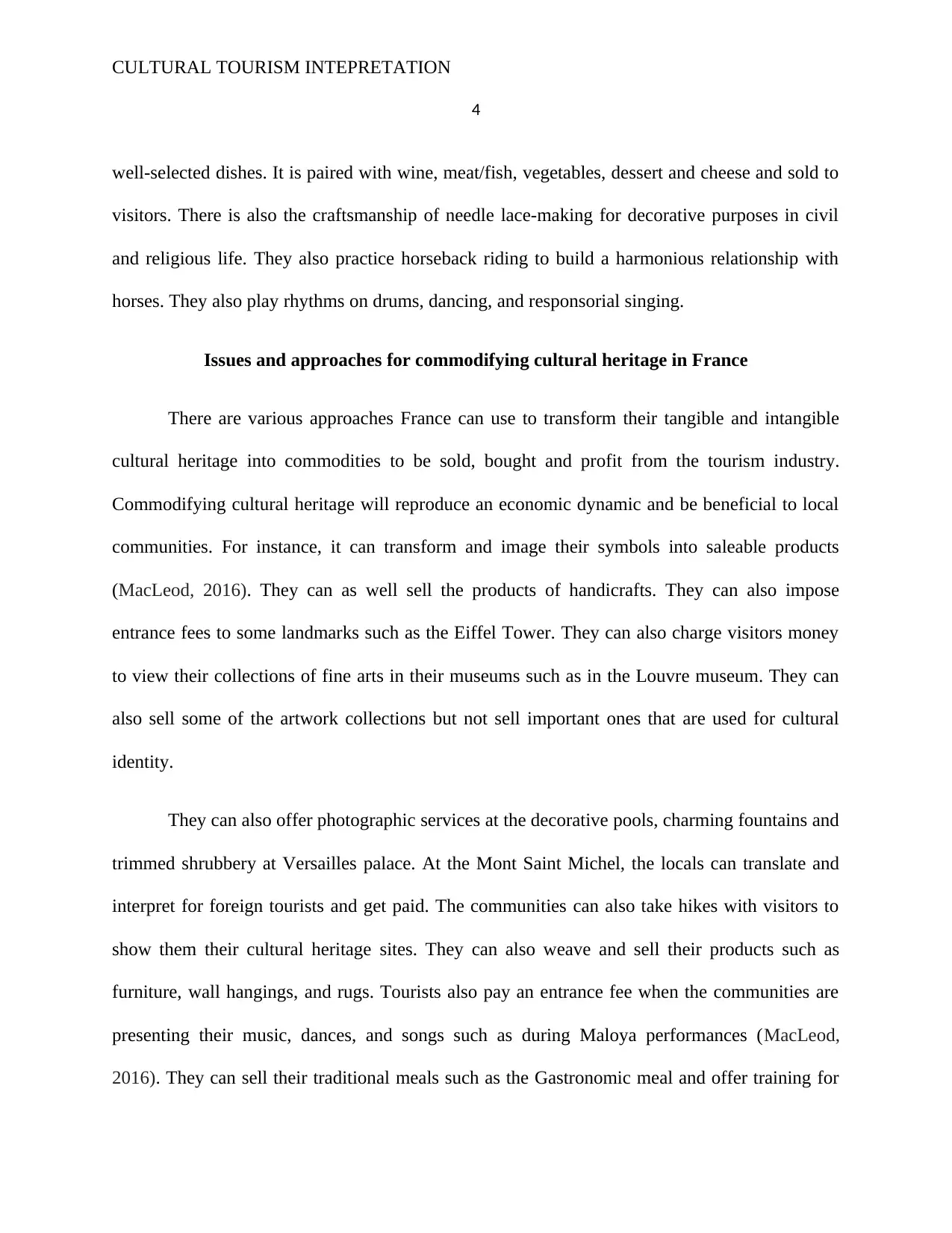
CULTURAL TOURISM INTEPRETATION
4
well-selected dishes. It is paired with wine, meat/fish, vegetables, dessert and cheese and sold to
visitors. There is also the craftsmanship of needle lace-making for decorative purposes in civil
and religious life. They also practice horseback riding to build a harmonious relationship with
horses. They also play rhythms on drums, dancing, and responsorial singing.
Issues and approaches for commodifying cultural heritage in France
There are various approaches France can use to transform their tangible and intangible
cultural heritage into commodities to be sold, bought and profit from the tourism industry.
Commodifying cultural heritage will reproduce an economic dynamic and be beneficial to local
communities. For instance, it can transform and image their symbols into saleable products
(MacLeod, 2016). They can as well sell the products of handicrafts. They can also impose
entrance fees to some landmarks such as the Eiffel Tower. They can also charge visitors money
to view their collections of fine arts in their museums such as in the Louvre museum. They can
also sell some of the artwork collections but not sell important ones that are used for cultural
identity.
They can also offer photographic services at the decorative pools, charming fountains and
trimmed shrubbery at Versailles palace. At the Mont Saint Michel, the locals can translate and
interpret for foreign tourists and get paid. The communities can also take hikes with visitors to
show them their cultural heritage sites. They can also weave and sell their products such as
furniture, wall hangings, and rugs. Tourists also pay an entrance fee when the communities are
presenting their music, dances, and songs such as during Maloya performances (MacLeod,
2016). They can sell their traditional meals such as the Gastronomic meal and offer training for
4
well-selected dishes. It is paired with wine, meat/fish, vegetables, dessert and cheese and sold to
visitors. There is also the craftsmanship of needle lace-making for decorative purposes in civil
and religious life. They also practice horseback riding to build a harmonious relationship with
horses. They also play rhythms on drums, dancing, and responsorial singing.
Issues and approaches for commodifying cultural heritage in France
There are various approaches France can use to transform their tangible and intangible
cultural heritage into commodities to be sold, bought and profit from the tourism industry.
Commodifying cultural heritage will reproduce an economic dynamic and be beneficial to local
communities. For instance, it can transform and image their symbols into saleable products
(MacLeod, 2016). They can as well sell the products of handicrafts. They can also impose
entrance fees to some landmarks such as the Eiffel Tower. They can also charge visitors money
to view their collections of fine arts in their museums such as in the Louvre museum. They can
also sell some of the artwork collections but not sell important ones that are used for cultural
identity.
They can also offer photographic services at the decorative pools, charming fountains and
trimmed shrubbery at Versailles palace. At the Mont Saint Michel, the locals can translate and
interpret for foreign tourists and get paid. The communities can also take hikes with visitors to
show them their cultural heritage sites. They can also weave and sell their products such as
furniture, wall hangings, and rugs. Tourists also pay an entrance fee when the communities are
presenting their music, dances, and songs such as during Maloya performances (MacLeod,
2016). They can sell their traditional meals such as the Gastronomic meal and offer training for
Secure Best Marks with AI Grader
Need help grading? Try our AI Grader for instant feedback on your assignments.
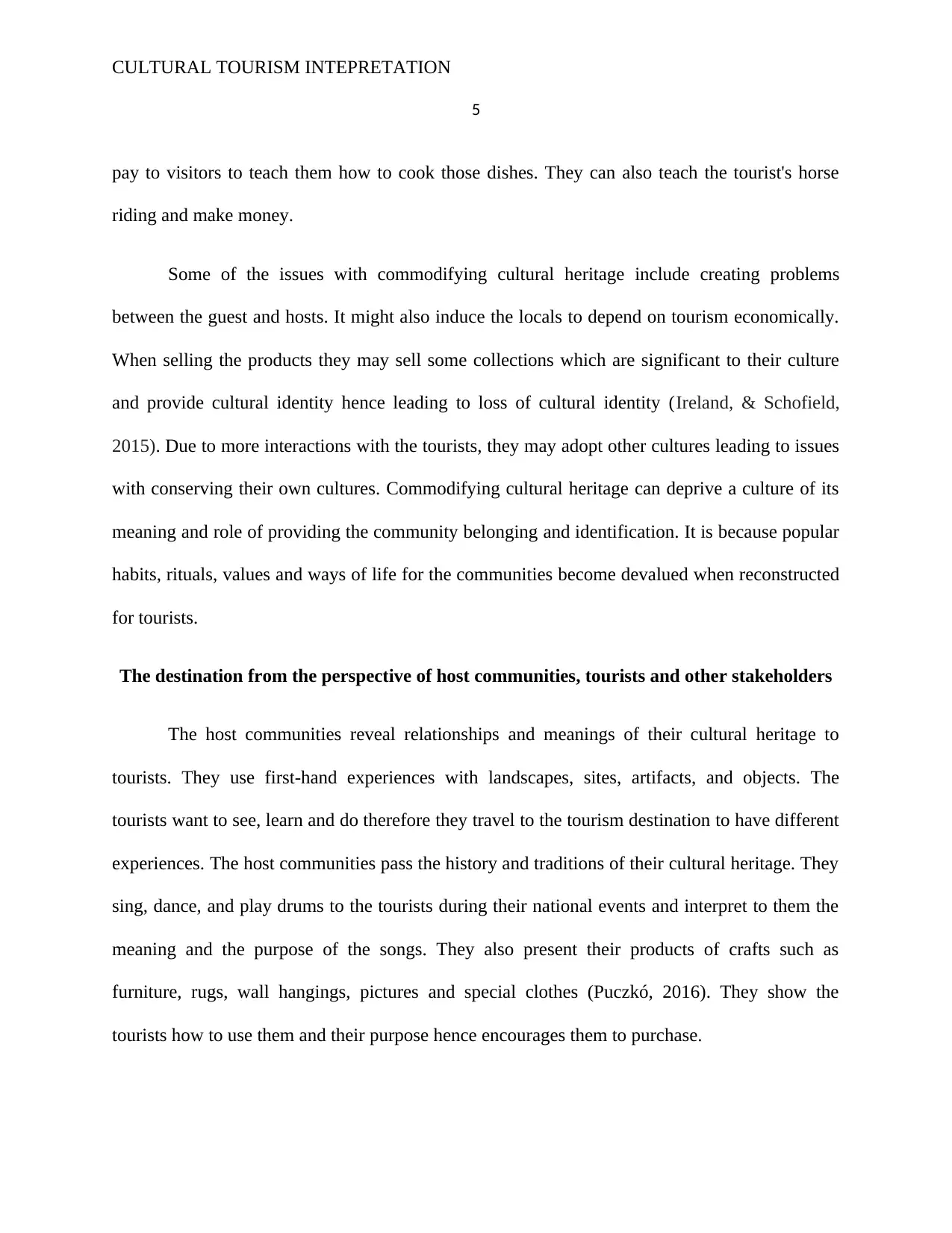
CULTURAL TOURISM INTEPRETATION
5
pay to visitors to teach them how to cook those dishes. They can also teach the tourist's horse
riding and make money.
Some of the issues with commodifying cultural heritage include creating problems
between the guest and hosts. It might also induce the locals to depend on tourism economically.
When selling the products they may sell some collections which are significant to their culture
and provide cultural identity hence leading to loss of cultural identity (Ireland, & Schofield,
2015). Due to more interactions with the tourists, they may adopt other cultures leading to issues
with conserving their own cultures. Commodifying cultural heritage can deprive a culture of its
meaning and role of providing the community belonging and identification. It is because popular
habits, rituals, values and ways of life for the communities become devalued when reconstructed
for tourists.
The destination from the perspective of host communities, tourists and other stakeholders
The host communities reveal relationships and meanings of their cultural heritage to
tourists. They use first-hand experiences with landscapes, sites, artifacts, and objects. The
tourists want to see, learn and do therefore they travel to the tourism destination to have different
experiences. The host communities pass the history and traditions of their cultural heritage. They
sing, dance, and play drums to the tourists during their national events and interpret to them the
meaning and the purpose of the songs. They also present their products of crafts such as
furniture, rugs, wall hangings, pictures and special clothes (Puczkó, 2016). They show the
tourists how to use them and their purpose hence encourages them to purchase.
5
pay to visitors to teach them how to cook those dishes. They can also teach the tourist's horse
riding and make money.
Some of the issues with commodifying cultural heritage include creating problems
between the guest and hosts. It might also induce the locals to depend on tourism economically.
When selling the products they may sell some collections which are significant to their culture
and provide cultural identity hence leading to loss of cultural identity (Ireland, & Schofield,
2015). Due to more interactions with the tourists, they may adopt other cultures leading to issues
with conserving their own cultures. Commodifying cultural heritage can deprive a culture of its
meaning and role of providing the community belonging and identification. It is because popular
habits, rituals, values and ways of life for the communities become devalued when reconstructed
for tourists.
The destination from the perspective of host communities, tourists and other stakeholders
The host communities reveal relationships and meanings of their cultural heritage to
tourists. They use first-hand experiences with landscapes, sites, artifacts, and objects. The
tourists want to see, learn and do therefore they travel to the tourism destination to have different
experiences. The host communities pass the history and traditions of their cultural heritage. They
sing, dance, and play drums to the tourists during their national events and interpret to them the
meaning and the purpose of the songs. They also present their products of crafts such as
furniture, rugs, wall hangings, pictures and special clothes (Puczkó, 2016). They show the
tourists how to use them and their purpose hence encourages them to purchase.
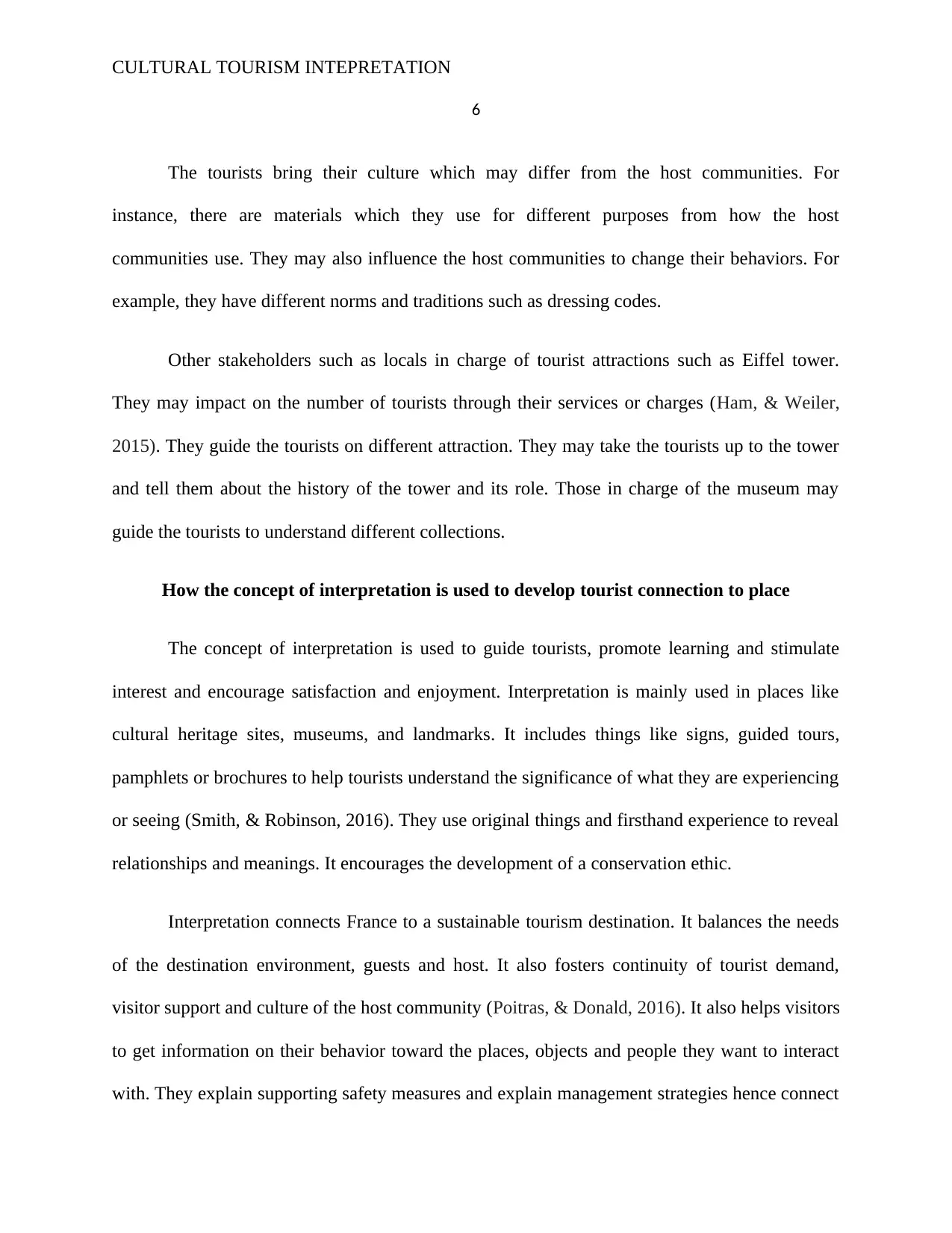
CULTURAL TOURISM INTEPRETATION
6
The tourists bring their culture which may differ from the host communities. For
instance, there are materials which they use for different purposes from how the host
communities use. They may also influence the host communities to change their behaviors. For
example, they have different norms and traditions such as dressing codes.
Other stakeholders such as locals in charge of tourist attractions such as Eiffel tower.
They may impact on the number of tourists through their services or charges (Ham, & Weiler,
2015). They guide the tourists on different attraction. They may take the tourists up to the tower
and tell them about the history of the tower and its role. Those in charge of the museum may
guide the tourists to understand different collections.
How the concept of interpretation is used to develop tourist connection to place
The concept of interpretation is used to guide tourists, promote learning and stimulate
interest and encourage satisfaction and enjoyment. Interpretation is mainly used in places like
cultural heritage sites, museums, and landmarks. It includes things like signs, guided tours,
pamphlets or brochures to help tourists understand the significance of what they are experiencing
or seeing (Smith, & Robinson, 2016). They use original things and firsthand experience to reveal
relationships and meanings. It encourages the development of a conservation ethic.
Interpretation connects France to a sustainable tourism destination. It balances the needs
of the destination environment, guests and host. It also fosters continuity of tourist demand,
visitor support and culture of the host community (Poitras, & Donald, 2016). It also helps visitors
to get information on their behavior toward the places, objects and people they want to interact
with. They explain supporting safety measures and explain management strategies hence connect
6
The tourists bring their culture which may differ from the host communities. For
instance, there are materials which they use for different purposes from how the host
communities use. They may also influence the host communities to change their behaviors. For
example, they have different norms and traditions such as dressing codes.
Other stakeholders such as locals in charge of tourist attractions such as Eiffel tower.
They may impact on the number of tourists through their services or charges (Ham, & Weiler,
2015). They guide the tourists on different attraction. They may take the tourists up to the tower
and tell them about the history of the tower and its role. Those in charge of the museum may
guide the tourists to understand different collections.
How the concept of interpretation is used to develop tourist connection to place
The concept of interpretation is used to guide tourists, promote learning and stimulate
interest and encourage satisfaction and enjoyment. Interpretation is mainly used in places like
cultural heritage sites, museums, and landmarks. It includes things like signs, guided tours,
pamphlets or brochures to help tourists understand the significance of what they are experiencing
or seeing (Smith, & Robinson, 2016). They use original things and firsthand experience to reveal
relationships and meanings. It encourages the development of a conservation ethic.
Interpretation connects France to a sustainable tourism destination. It balances the needs
of the destination environment, guests and host. It also fosters continuity of tourist demand,
visitor support and culture of the host community (Poitras, & Donald, 2016). It also helps visitors
to get information on their behavior toward the places, objects and people they want to interact
with. They explain supporting safety measures and explain management strategies hence connect
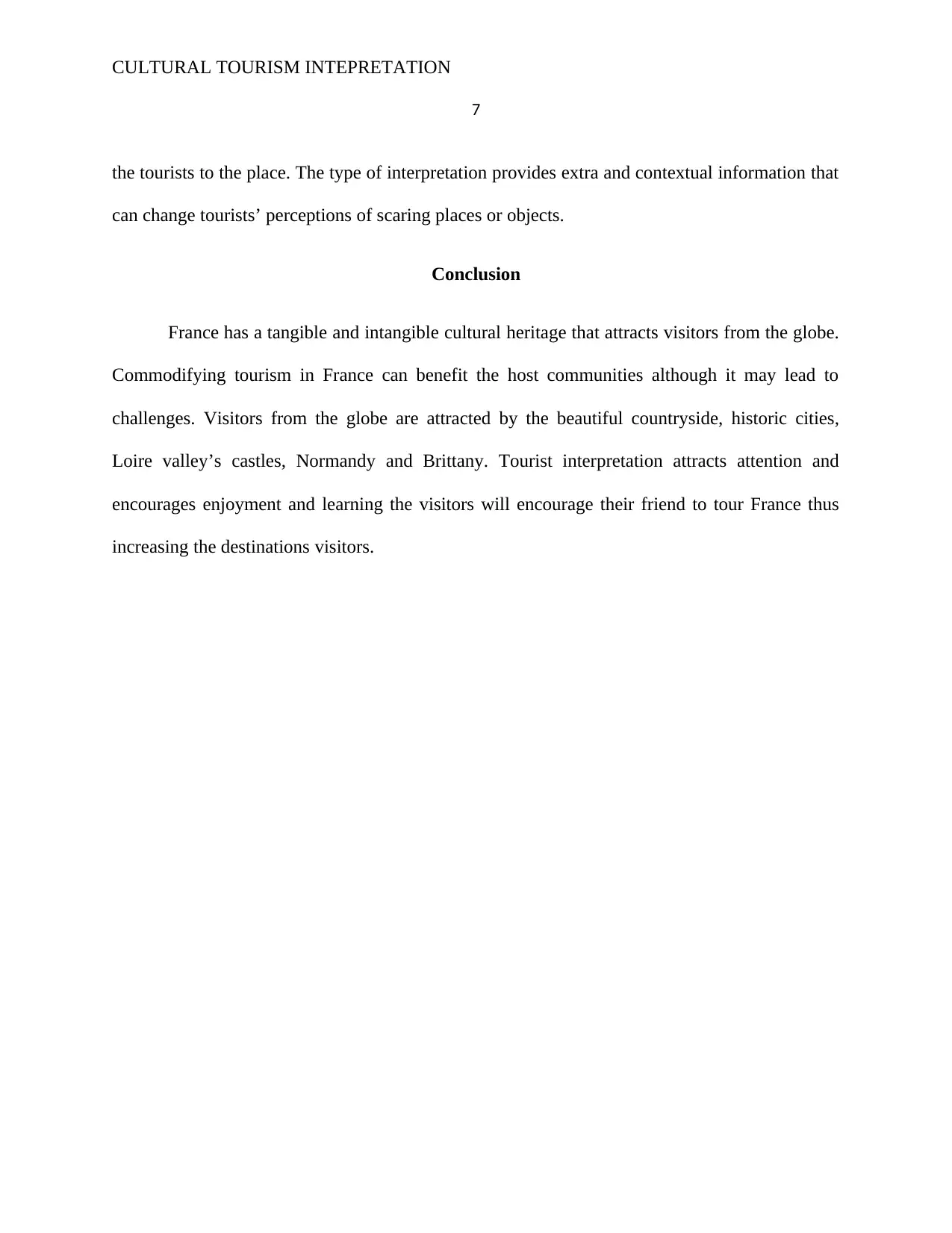
CULTURAL TOURISM INTEPRETATION
7
the tourists to the place. The type of interpretation provides extra and contextual information that
can change tourists’ perceptions of scaring places or objects.
Conclusion
France has a tangible and intangible cultural heritage that attracts visitors from the globe.
Commodifying tourism in France can benefit the host communities although it may lead to
challenges. Visitors from the globe are attracted by the beautiful countryside, historic cities,
Loire valley’s castles, Normandy and Brittany. Tourist interpretation attracts attention and
encourages enjoyment and learning the visitors will encourage their friend to tour France thus
increasing the destinations visitors.
7
the tourists to the place. The type of interpretation provides extra and contextual information that
can change tourists’ perceptions of scaring places or objects.
Conclusion
France has a tangible and intangible cultural heritage that attracts visitors from the globe.
Commodifying tourism in France can benefit the host communities although it may lead to
challenges. Visitors from the globe are attracted by the beautiful countryside, historic cities,
Loire valley’s castles, Normandy and Brittany. Tourist interpretation attracts attention and
encourages enjoyment and learning the visitors will encourage their friend to tour France thus
increasing the destinations visitors.
Paraphrase This Document
Need a fresh take? Get an instant paraphrase of this document with our AI Paraphraser
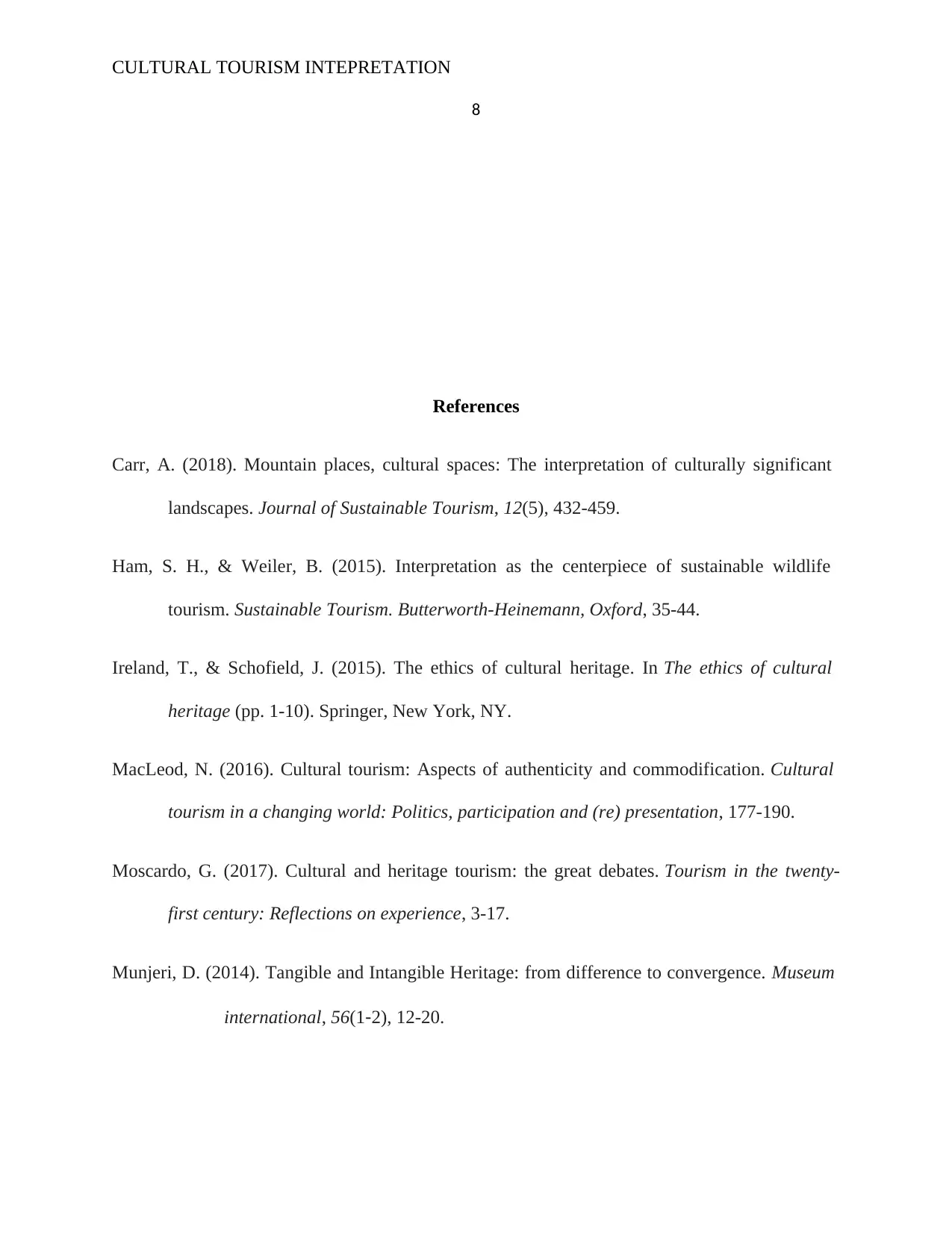
CULTURAL TOURISM INTEPRETATION
8
References
Carr, A. (2018). Mountain places, cultural spaces: The interpretation of culturally significant
landscapes. Journal of Sustainable Tourism, 12(5), 432-459.
Ham, S. H., & Weiler, B. (2015). Interpretation as the centerpiece of sustainable wildlife
tourism. Sustainable Tourism. Butterworth-Heinemann, Oxford, 35-44.
Ireland, T., & Schofield, J. (2015). The ethics of cultural heritage. In The ethics of cultural
heritage (pp. 1-10). Springer, New York, NY.
MacLeod, N. (2016). Cultural tourism: Aspects of authenticity and commodification. Cultural
tourism in a changing world: Politics, participation and (re) presentation, 177-190.
Moscardo, G. (2017). Cultural and heritage tourism: the great debates. Tourism in the twenty-
first century: Reflections on experience, 3-17.
Munjeri, D. (2014). Tangible and Intangible Heritage: from difference to convergence. Museum
international, 56(1‐2), 12-20.
8
References
Carr, A. (2018). Mountain places, cultural spaces: The interpretation of culturally significant
landscapes. Journal of Sustainable Tourism, 12(5), 432-459.
Ham, S. H., & Weiler, B. (2015). Interpretation as the centerpiece of sustainable wildlife
tourism. Sustainable Tourism. Butterworth-Heinemann, Oxford, 35-44.
Ireland, T., & Schofield, J. (2015). The ethics of cultural heritage. In The ethics of cultural
heritage (pp. 1-10). Springer, New York, NY.
MacLeod, N. (2016). Cultural tourism: Aspects of authenticity and commodification. Cultural
tourism in a changing world: Politics, participation and (re) presentation, 177-190.
Moscardo, G. (2017). Cultural and heritage tourism: the great debates. Tourism in the twenty-
first century: Reflections on experience, 3-17.
Munjeri, D. (2014). Tangible and Intangible Heritage: from difference to convergence. Museum
international, 56(1‐2), 12-20.
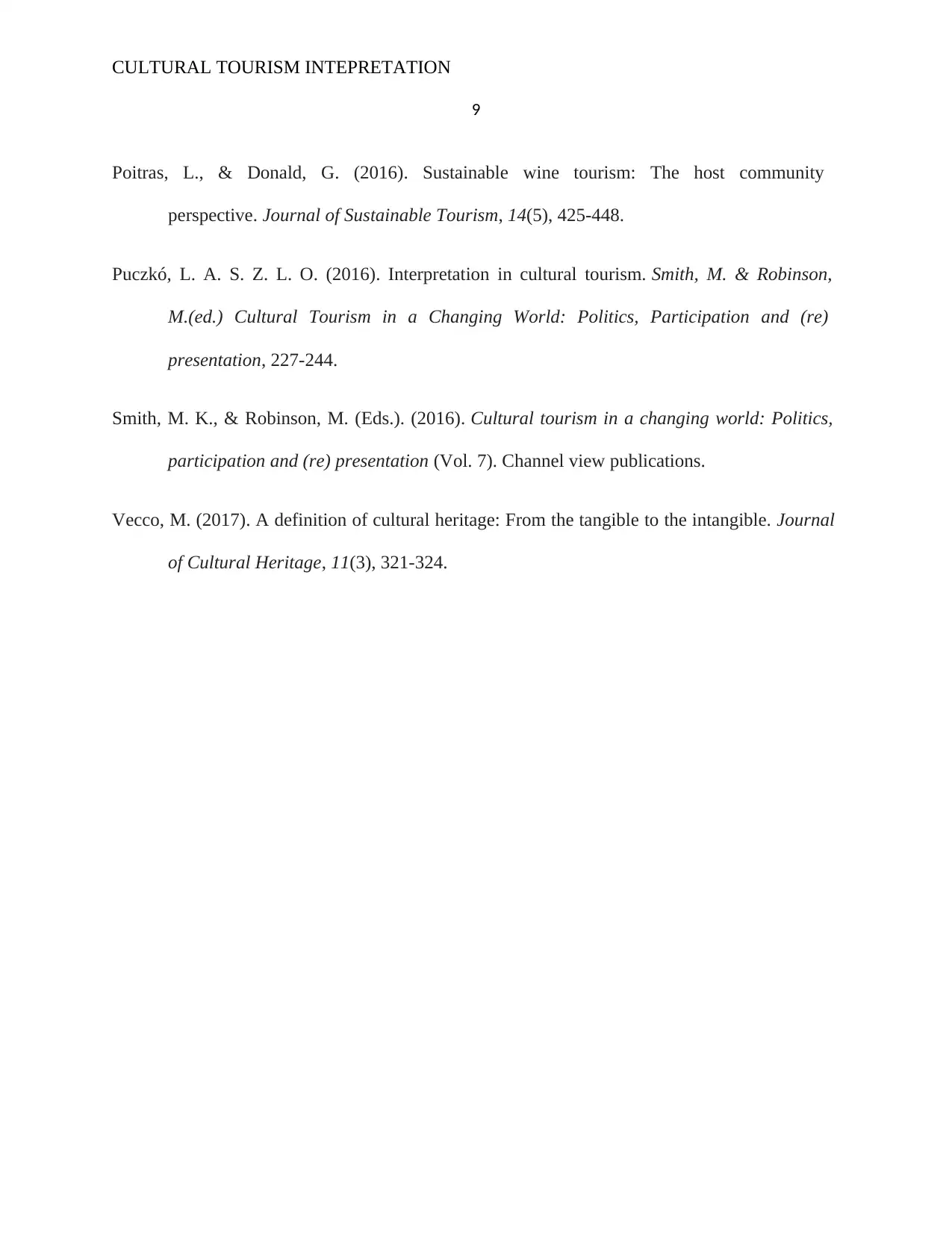
CULTURAL TOURISM INTEPRETATION
9
Poitras, L., & Donald, G. (2016). Sustainable wine tourism: The host community
perspective. Journal of Sustainable Tourism, 14(5), 425-448.
Puczkó, L. A. S. Z. L. O. (2016). Interpretation in cultural tourism. Smith, M. & Robinson,
M.(ed.) Cultural Tourism in a Changing World: Politics, Participation and (re)
presentation, 227-244.
Smith, M. K., & Robinson, M. (Eds.). (2016). Cultural tourism in a changing world: Politics,
participation and (re) presentation (Vol. 7). Channel view publications.
Vecco, M. (2017). A definition of cultural heritage: From the tangible to the intangible. Journal
of Cultural Heritage, 11(3), 321-324.
9
Poitras, L., & Donald, G. (2016). Sustainable wine tourism: The host community
perspective. Journal of Sustainable Tourism, 14(5), 425-448.
Puczkó, L. A. S. Z. L. O. (2016). Interpretation in cultural tourism. Smith, M. & Robinson,
M.(ed.) Cultural Tourism in a Changing World: Politics, Participation and (re)
presentation, 227-244.
Smith, M. K., & Robinson, M. (Eds.). (2016). Cultural tourism in a changing world: Politics,
participation and (re) presentation (Vol. 7). Channel view publications.
Vecco, M. (2017). A definition of cultural heritage: From the tangible to the intangible. Journal
of Cultural Heritage, 11(3), 321-324.
1 out of 9
Related Documents
Your All-in-One AI-Powered Toolkit for Academic Success.
+13062052269
info@desklib.com
Available 24*7 on WhatsApp / Email
![[object Object]](/_next/static/media/star-bottom.7253800d.svg)
Unlock your academic potential
© 2024 | Zucol Services PVT LTD | All rights reserved.





